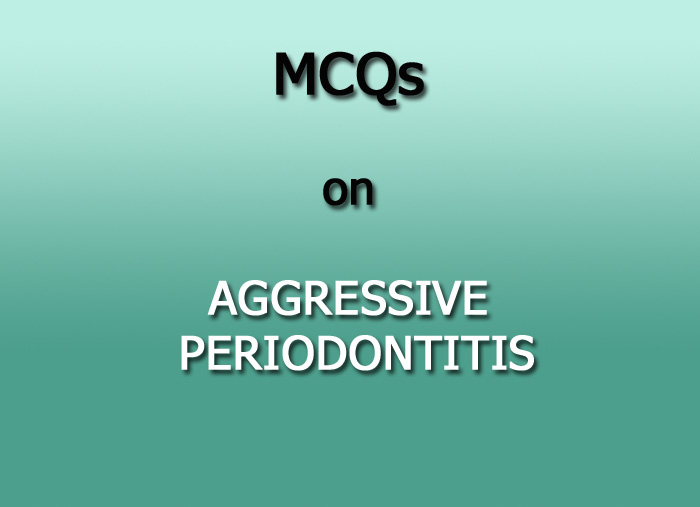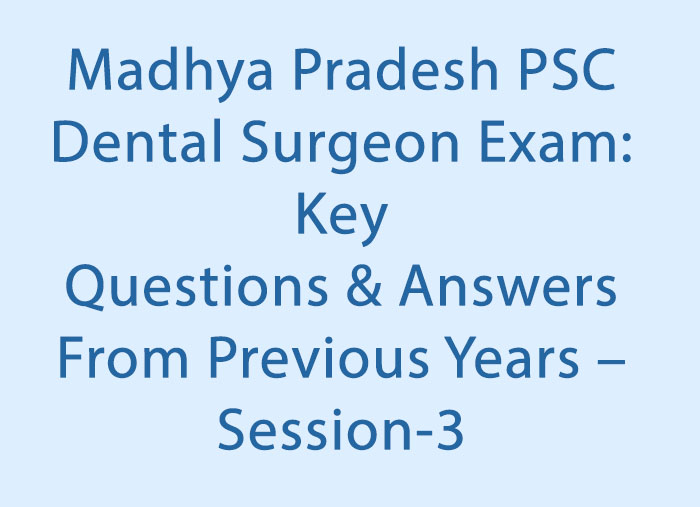- NEED HELP? CALL US NOW
- +919995411505
- [email protected]

1. The bacteria detected in localized aggressive periodontitis are:
A. Borreliavincenti, medium size spirochetes.
B. Fusiformis, Tanerellaforsythus.
C. Actinobacillusactinomycetemcomitans, capnocytophaga Spp., Eikenellacorrodens, campylobacter rectus, prevotella intermedia.
D. Mycoplasma, capnocytophagasputigena, spirocheles.
Answer : C
2. 16 years boy, present clinically with attachment loss related to 1st Molars and Incisors only. Diagnosis of this case according to AAP 1999 periodontal Diseases Classification is:
A. Localized aggressive periodontitis.
B. Generalized aggressive periodontitis.
C. Generalized juvenile periodontitis.
D. Localized juvenile periodontitis.
Answer :A
Localised Aggressive Periodontitis
| AGE OF ONSET | Circumpubertal |
| DISTRIBUTION | Localized first molar/incisor presentation with interproximal attachment loss on at least two permanent teeth, one of which is a first molar, and involving not more than two teeth other than first molars and incisors. |
| SEVERITY | Rapid and severe loss of alveolar bone |
| AETIOLOGY | Predominantly A.actinomycetumcomitans |
| IMMUNOLOGICAL RESPONSE | Robust serum antibody response to infecting agents |
| PRESENCE OF LOCAL FACTORS | Amount of plaque on the affected tooth is minimal that is inconsistent with amount of periodontal destruction |
| FAMILIAL PATTERN | Strong association |
| GINGIVAL INFLAMMATION | lack of clinical inflammation despite the presence of deep periodontal pockets and advanced bone loss |
| RADIOGRAPHIC APPEARANCE | Vertical bone loss affecting: first permanent molars & incisors, usually bilateral. “Arc-shape” loss of alveolar bone extending from the distal of the 2nd premolar to the mesial of the 2nd molar |
3. Localized aggressive periodontitis is best treated in early Stage by:
A. Tetracycline 250mg 4 times daily for fourteen days.
B. Tetracycline 250mg once daily for 7 days.
C. Tetracycline 250mg twice daily for 7 days.
D. Tetracycline 250mg 4 times daily for 3 days.
Answer : A
4. Localized aggressive periodontitis is characterized by the following except
A. Non contributory medical history
B. Rapid attachment loss
C. Pathologic migration
D. Familial aggregation of cases
Answer:C
5. The causes of bone destruction in aggressive periodontitis is
A. Phagocytosis are reduced
B. Reduced neutrophilic chemotaxis
C. Decreased host resistance
D. Highly virulent micro organism
Answer: B
6. Pre pubertal periodontitis occurs
A. Before 11 yrs
B. At 12-15 yrs
C. At 18 yrs of age
D. After 20 yrs
Answer:A
7.”mirror image” type of bone loss pattern is seen in
A. Localized juvenile periodontitis
B. Rapidly progressive periodontitis
C. Pre pubertal periodontitis
D. Adult periodontitis
Answer:A
8.Rapidly progressive periodontitis is seen usually at which age?
A. 6-10yrs
B. 10-20yrs
C. 30-40yrs
D. At any age
Answer:B
9.Which of the following periodontal diseases does not have calculus?
A. ANUG
B. Chronic Adult periodontitis
C. juvenile periodontitis
D. periodontal abscess
Answer :C
10.First clinical signLocalized juvenile periodontitis
A. Tooth mobility
B. Gingival bleeding
C. Pathologic migration
D. Vertical bone loss along incisors and molars
Answer :C




